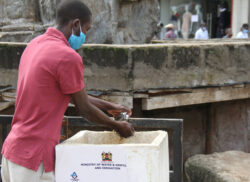
Shortly after President Kenyatta announced his Big Four Agenda, with an emphasis on UHC, many people were unsure about it. Some thought UHC meant free medical services regardless of one’s background, status, education or place of residence. Others thought it meant every Kenyan must be insured, while others interpreted UHC to mean well-equipped hospitals, with enough doctors and medications.
While speaking at a stakeholder’s health forum in Nairobi, Regina Ombam, the Deputy Director, HIV Investments, at National Aids Control Council, said that while all of the above are true to some extent, Universal Health Coverage could be achieved without big investments, and by people themselves.
She recalled that in the 1970s to 1990s, when she was growing up: “We did not have these huge private hospitals you see today. People went to Level One facilities, government dispensaries and clinics in the villages.”
Ms Ombam added that the most visible and memorable phenomena at that time were health extension officers, who walked around homes making sure people were adhering to sanitation and hygiene.
“The extension officers would come to make sure that people were clearing bushes, that there was no stagnant water, and that water was boiled before drinking.”
This helped prevent diseases, rather than waiting until one fell sick, like many Kenyans are wont to do today, then rush to the hospital. This is the spirit of primary healthcare, which focuses on promotive and preventive aspects.
Indeed, PHC would keep diseases like malaria and diarrhea in check. Diarrhoea is a serious health risk. The UN says that inadequate sanitation is estimated to cause 432,000 diarrhoeal deaths every year and is a major factor in diseases like intestinal worms, trachoma and schistomiasis. Each year, 297,000 children under five years are estimated to die from diarrhoea as a result of unsafe drinking water, sanitation and hand hygiene.
In a study by Martin Gambril published in Nairobi in February 2018, and titled Introduction to a Comprehensive Countrywide Approach to Sanitation, inadequate sanitation is shown to have ‘tremendous costs’ including economic impact on households, diarrhea and other waterborne diseases, time spent looking for a safe space to defecate or while queuing at public toilets, impact on productivity due to sickness, time missed at work, school, physical stunting, and huge implications on biodiversity, rivers, coastal environment, and many more.
The UN says loss of productivity due to water and sanitation related diseases may cost many countries up to 5 percent of GDP.
The loss is hard to bear since sanitation and hygiene involve simple individual and community-based interventions as envisioned by Primary Health Care. Here are a few interventions:
One, handwashing by soap and water, including before eating, after visiting the toilet and after handling soiled nappies or diapers.
Two, eschewing open defecation, which is still common in some communities. It could be solved through construction of pit latrines and provision of public toilets in rural areas and informal settlements.
Handwashing and open defecation are important to health outcomes and have been dedicated with commemorative days. For the former, it is Global Handwashing Day, marked every year on October 15, and dedicated to advocating for handwashing with soap as an easy, effective and affordable way to prevent diseases and save lives.
The day seeks creative ways to wash hands, noting that not every school or home can afford a sink. People are advised to use locally available materials like plastic containers or discarded water bottles than can be hung strategically on poles and walls at schools and other public institutions.
A few weeks later, the globe marks the World Toilet Day on November 19. According to the UN, the day is meant to inspire action on the global sanitation crisis and help achieve Sustainable Development Goal 6 – sanitation for all by 2030.
In cognisant of this, and the fact that countries have not achieved health gains from sanitation while there is lack of a sanitation policy, the World Health Organisation in October 2018 released the first-ever Guidelines on Sanitation and Health.
The guidelines’ recommendations include:
- Sanitation interventions should ensure entire communities have access to toilets that safely contain excreta.
- The full sanitation system should undergo local health risk assessments to protect individuals and communities from exposure to excreta – whether from unsafe toilets, leaking storage or inadequate treatment.
- Sanitation should be integrated into regular, local, government-led planning and service provision to avert the higher costs associated with retrofitting sanitation, and to ensure sustainability. The health sector should invest more and play a coordinating role in sanitation planning.
